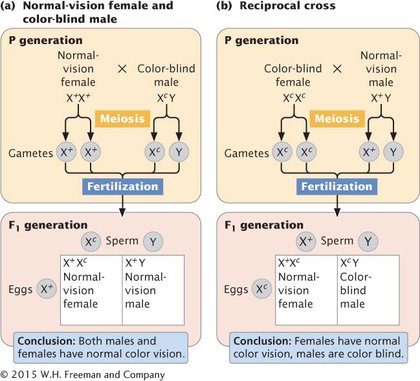X-Linked Color Blindness in Humans
To further examine X-linked inheritance, let’s consider another X-linked characteristic: red–green color blindness in humans. Mutations that produce defective color vision are generally recessive, and because the genes encoding the red and the green photoreceptors are located on the X chromosome, red–green color blindness is inherited as an X-linked recessive characteristic.
We will use the symbol Xc to represent the allele for red–green color blindness and the symbol X+ to represent the allele for normal color vision. Females possess two X chromosomes, so there are three possible genotypes among females: X+X+ and X+Xc, which produce normal color vision, and XcXc, which produces color blindness. Males have only a single X chromosome and two possible genotypes: X+Y, which produces normal vision, and XcY, which produces color blindness.
Let's consider what happens when a woman homozygous for normal color vision mates with a color-blind man (Figure 4.10a). All the gametes produced by the woman will contain an allele for normal color vision. Half of the man’s gametes will receive the X chromosome with the color-blindness allele, and the other half will receive the Y chromosome, which carries no alleles affecting color vision. When an Xc-bearing sperm unites with the X+-bearing egg, a heterozygous female with normal vision (X+Xc) is produced. When a Y-bearing sperm unites with the X-bearing egg, a hemizygous male with normal vision (X+Y) is produced.

Figure 4.10: Red–green color blindness is inherited as an X-linked recessive trait in humans.
In the reciprocal cross between a color-blind woman and a man with normal color vision (Figure 4.10b), the woman produces only Xc-bearing gametes. The man produces some gametes that contain the X chromosome and others that contain the Y chromosome. Males inherit the X chromosome from their mothers; because both of the mother’s X chromosomes bear the Xc allele in this case, all the male offspring will be color blind. In contrast, females inherit an X chromosome from both parents; thus all the female offspring of this reciprocal cross will be heterozygous with normal vision. Females are color blind only when color-blindness alleles have been inherited from both parents, whereas a male only needs to inherit a color-blindness allele from his mother to be color blind; for this reason, color blindness and most other rare X-linked recessive characteristics are more common in males than in females.
In these crosses for color blindness, notice that an affected woman passes the X-linked recessive trait to her sons, but not to her daughters, whereas an affected man passes the trait to his grandsons through his daughters, but never to his sons. X-linked recessive characteristics may therefore appear to alternate between the sexes, appearing in females in one generation and in males in the next generation.
WORKED PROBLEM
Now that we understand the pattern of X-linked inheritance, let’s apply our knowledge to answer a specific question.
Betty has normal vision, but her mother is color blind. Bill is color blind. If Bill and Betty marry and have a child together, what is the probability that the child will be color blind?
What information is required in your answer to the problem?
The probability that Bill and Betty’s child will be color blind.
What information is provided to solve the problem?
The phenotypes of Betty, Betty’s mother, and Bill.
Because color blindness is an X-linked recessive trait, Betty’s color-blind mother must be homozygous for the color-blindness allele (XcXc). Females inherit one X chromosome from each of their parents, so Betty must have inherited a color-blindness allele from her mother. Because Betty has normal color vision, she must have inherited an allele for normal vision (X+) from her father; thus Betty is heterozygous (X+Xc). Bill is color blind. Because males are hemizygous for X-linked alleles, he must be (XcY). A mating between Betty and Bill is represented as
Thus, the overall probability that their child will be color blind is ½.
 Get some additional practice with X-linked inheritance by working Problem 15 at the end of this chapter.
Get some additional practice with X-linked inheritance by working Problem 15 at the end of this chapter.
CONCEPTS
Characteristics determined by genes on the sex chromosomes are called sex-linked characteristics. In organisms with XX-XY sex determination, diploid females have two alleles at each X-linked locus, whereas diploid males possess a single allele at each X-linked locus. Females inherit X-linked alleles from both parents, but males inherit a single X-linked allele from their mothers.
 CONCEPT CHECK 4
CONCEPT CHECK 4
Hemophilia (reduced blood clotting) is an X-linked recessive disease in humans. A woman with hemophilia mates with a man who exhibits normal blood clotting. What is the probability that their child will have hemophilia?
All of their male offspring will have hemophilia, and none of their female offspring will have hemophilia, so the overall probability of hemophilia in their offspring is ½.


 Get some additional practice with X-
Get some additional practice with X- CONCEPT CHECK 4
CONCEPT CHECK 4